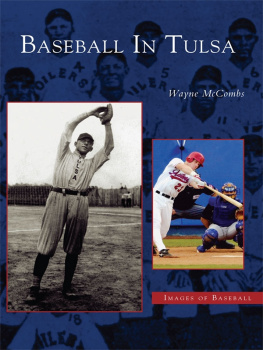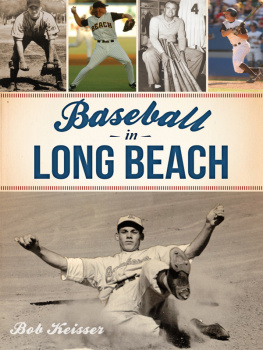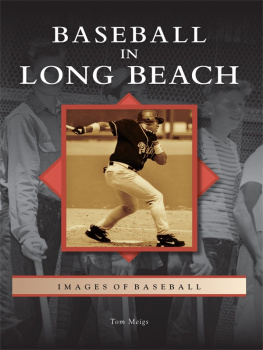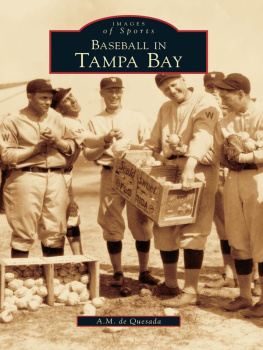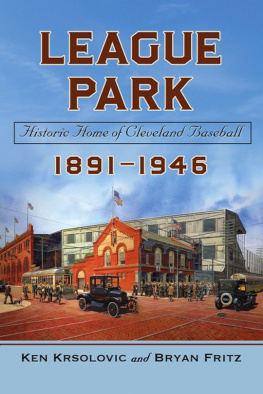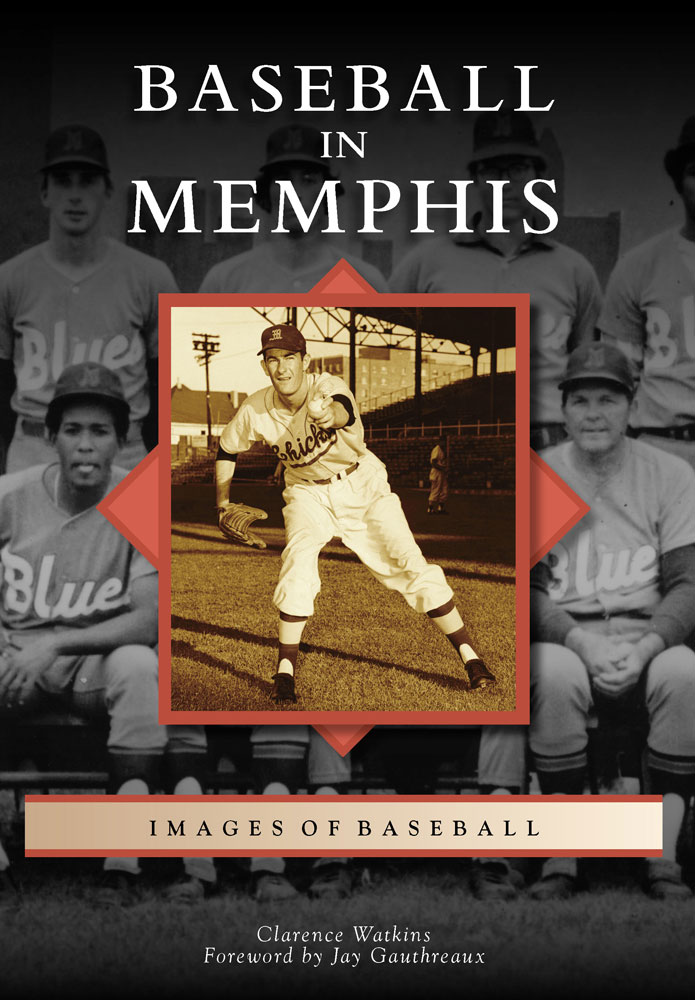
BASEBALL
IN
MEMPHIS

What happens when a small boy dresses up in his own Chicks uniform? Someone buys him a Ray Crone Spalding baseball glove. Crone was from Memphis and played for the Memphis Chicks in 1959. In the summer, the boy goes to sleep listening to Chicks and Cardinals baseball radio broadcasts coming from the next room, where his grandfather sleeps. As a teenager, the boy drifts from his love of baseball, but the Oakland As dynasty of the early 1970s rekindles his passion for the sport. Later, as a young man, he goes to a baseball card show in Memphis, where an elderly gentleman, Al Price, is selling old scorecards of Southern Association teams. The young man must have the 1950s Memphis Chicks program with the majestic Chickasaw chief profiled on the cover. From that time on, the rediscovery of the history of baseball in Memphis would be part of his life and eventually culminate in the writing of this book. (Authors collection.)
FRONT COVER: Memphis Chicks pitcher Tom Flanigan (19541956) shows off his excellent pitching technique. (Authors collection.)
COVER BACKGROUND: The 1974 Memphis Blues pose for a team picture. (Courtesy of Memphis and Shelby County Room, Memphis Public Library and Information Center.)
BACK COVER: A wonderful aerial shot of downtown Memphis features AutoZone Park, the Pyramid, the Mississippi River, and the Hernando DeSoto Bridge. (Courtesy of Larry Inman/Memphis Redbirds.)
BASEBALL
IN
MEMPHIS

Clarence Watkins
Foreword by Jay Gauthreaux

Copyright 2012 by Clarence Watkins
ISBN 978-0-7385-9108-7
Ebook ISBN 9781439642238
Published by Arcadia Publishing
Charleston, South Carolina
Library of Congress Control Number: 2011932734
For all general information, please contact Arcadia Publishing:
Telephone 843-853-2070
Fax 843-853-0044
E-mail
For customer service and orders:
Toll-Free 1-888-313-2665
Visit us on the Internet at www.arcadiapublishing.com
This book is dedicated to Memphis baseball fans, whether you followed the Chicks, Red Sox, Blues, Redbirds, or all of the above. I hope this book strengthens your memories and revitalizes your interest. I hope it may also help create a new generation of fans interested in keeping the great history of the Memphis teams alive for the future.
To my wife, Carol, thank you for your patience during this time of preparation for the book and your help in placing my thoughts onto paper.
CONTENTS
Going through the box scores was a treat for a young baseball fan growing up in New Orleans. Studying the stats, along with articles each week, provided an insight into the heroes who took the field. As a lifelong fan of the sport, I have a deep sense of appreciation for the players and teams who were part of the identity of the city.
In the Bluff City of Memphis, Tennessee, the history of baseball is strong in the ranks of high schools, colleges, and every level of minor-league baseball. The ballparks they played in served not only as a second home during the days of summer innocence, but as a church of hope as fans prayed for a Memphis win.
Memphis native and fellow SABR (Society of American Baseball Research) member Clarence Watkins can relate to these days in his new work, Baseball in Memphis. Clarence takes the reader on a historical tour through the good and bad days, from when a Memphis team first joined the old Southern League through todays Pacific Coast League teams. The images in Clarences book show the ballplayers living out their dreams, earning a paycheck by chasing or hitting a round white spherewhich was better than milking cows or selling suits.
The city of Memphis identified with the players who graced the ballparks through the good and bad seasons in the Bluff City. This is why the history of baseball in Memphis is still special to fans who treasure those memories and to future fans who will start collecting theirs.
Jay Gauthreaux
The research for Baseball in Memphis has been a long and winding road. What started out as curiosity developed into an obsession. Only in the last two years did the idea of a book become a reality. Along the way, many people provided pieces to the great puzzle, and often the importance of this information was not understood until years later.
I must thank my fellow Southern Association researchers who have provided encouragement and important artifacts: Chris Drago, Jay Gauthreaux, Bill Plott, Skip Nipper, and Dan Creed. The staff at the Memphis Public Library in the Memphis Room was most helpful in locating long-forgotten manuscripts.
I also want to thank Jordan Johnson and Allison Rhoades from the Memphis Redbirds for their help with the Redbirds chapter. My thanks continue to Ben Powell for granting use of his photographs of AutoZone Park. Also, I want to thank my younger brothers Randy and Terry for filling in the gaps of Memphis baseball history when I moved away from Memphis.
In every Southern League city I have researched, I have always found a person who, in past years, kept the history of the team aliveeven when fans no longer cared. I call this person the flame keeper. For Memphis, the flame keeper is John Guinozzo. John first published his Memphis Baseball Encyclopedia in 1980 and has continued to print updates throughout the past 31 years. My thanks go to John for being the flame keeper for Baseball in Memphis.
And, finally, I want to thank Joe B. Scott, a great gentleman who treated me like an old friend from his days with the Memphis Red Sox. The two hours I spent with him in his home were baseball heaven.
At one of the book signings for Baseball in Birmingham, an incident occurred that made me want to write another book of baseball history. An elderly woman came into the bookstore with business other than buying one of my books. When she saw me at a table, she approached and asked what my book was about. After I gave her a brief summary, she told me about her memories as a child going to baseball games at Rickwood Field with her dad. Because her parents had no sons, and she was the youngest of several daughters, she got to go with him. She briefly paused before she said, That was the only time I had my father all to myself! It is my hope that writing this book about the history of Memphis baseball will evoke equally meaningful memories for baseball fans in Memphis.
Memphis was also a key player in the formation of the first Southern League in baseball. Before professional baseball in 1885, Memphis had an array of great amateur teams to fuel the love of the sport for its citizens. Teams such as the Red Sox, the Blues, and the Eckfords gave Memphis a strong foundation and knowledgeable fan base. During the absence of professional baseball before 1900, the Mighty Chickasaws claimed championships for the state and region, traveling to New Orleans, Nashville, Huntsville, and Selma to take on all rivals.
Prior to 1900, Memphis had several baseball parks, including Olympic, Citizen, Cycle, Chickasaw, and Red Elm Bottom. It is Red Elm Bottom that would evolve into Red Elm Park, and later into Russwood Park that we have such fond memories of. Let us take a walk back in time to become reacquainted with the heroes of the game: Ed Hurlburt, Dazzy Vance, Pete Gray, Doc Prothro, Johnny Antonelli, and Razor Shines. Baseball in Memphis was much more than a game.
Next page


